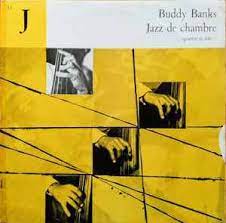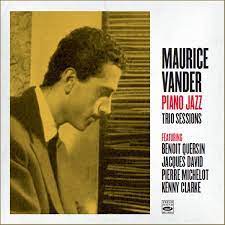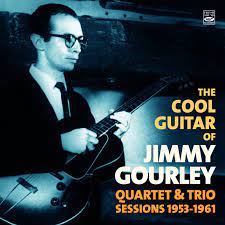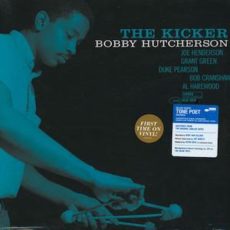
The Quarantined Jazz Voyager
This week the Jazz Voyager is choosing from the library of rare gems seldom heard on this side of the pond. Thanks to the internet, as you listen to the twenty-nine minutes of the album, remember to keep vigilant about the safety of your health and others. On the turntable is the hard bop Jazz De Chambre, a 1954 recording by double bassist Buddy Banks.
Buddy Banks, originally a saxophonist who switched to bass, had arrived in Europe after World War II. On this session he is accompanied by drummer Roy Haynes, pianist Bob Dorough, and guitarist Jimmy Gourley. The leader takes the spotlight in a subtle take of Yesterdays, though a strange clicking mars an otherwise swinging “I Love You.” Banks’ group also offers serviceable interpretations of modern pieces like Gerry Mulligan’s Line for Lyons and Milt Jackson’s Bag’s Groove.
The album was recorded at Geneix Studio in Paris, France and was produced by Frank Ténot. The liner notes were provided by Alain Tercinet with English translation by Martin Davies.
Tracks | 32:56- A Night In Tunisia (Dizzy Gillespie / Frank Paparelli) ~ 4:26
- Almost Like Being In Love (lan Jay Lerner / Frederick Loewe) ~ 3:19
- Bag’s Groove (Milt Jackson) ~ 3:47
- Yesterdays (Otto Harbach / Jerome Kern) ~ 3:29
- I Love You (Cole Porter) ~ 5:58
- Line For Lyons (Gerry Mulligan) ~ 3:46
- You Go To My Head (J. Fred Coots / Haven Gillespie) ~ 4:29
- Buddy Banks Blues (Buddy Banks) ~ 3:27
- Bob Dorough ~ piano
- Buddy Banks ~ double bass
- Jimmy Gourley ~ guitar
- Roy Haynes ~ drums
More Posts: adventure,album,club,double bass,genius,jazz,museum,music,preserving,restaurant,travel

Daily Dose Of Jazz…
Maurice Vander born Vanderschueren, on June 11, 1929 in Vitry-sur-Seine, Val-de-Marne, France. He worked in the 1950s with Don Byas, Django Reinhardt, Bobby Jaspar, Jimmy Raney, Stephane Grappelli, Chet Baker, and Kenny Clarke.
In the 1960s he was a session musician for Roger Guerin, Pierre Gossez, and Boulou Ferré, and played with Claude Nougaro and Ivan Jullien. He won the Prix Django Reinhardt in 1962.
Playing with Baker again in the late 1970s he went on to work with Johnny Griffin. His later work included performing and recording with Clarke, Richie Cole, Art Farmer, and Benny Powell.
Pianist Maurice Vander transitioned on February 16, 2017 in Paris, France.
More Posts: history,instrumental,jazz,music,piano

Daily Dose Of Jazz…
James Pasco Gourley, Jr. was born June 9, 1926 in St. Louis, Missouri. He met saxophonist Lee Konitz in Chicago when both were members of the same high school band and credits Konitz with encouraging him to become a serious musician.
His father started the Monarch Conservatory of Music in Hammond, Indiana, though he didn’t teach and bought his son his first guitar. Jimmy took his first guitar classes at the school and became interested in jazz while listening to the radio, enjoying in particular Nat King Cole. For his first professional experience as a performer, he dropped out of high school to play with a jazz band in Oklahoma City, Oklahoma.
From 1944 to 1946 Gourley served in the U.S. Navy. Upon his return to Chicago, Illinois he met guitarist Jimmy Raney and wanted to play like him. He worked in bars and clubs with Jackie Cain & Roy Kral, Anita O’Day, Sonny Stitt, and Gene Ammons. Through the G.I. Bill he received tuition for three years to any college in the world.
Beginning in 1951, Jimmy spent the rest of his life in France, working with Henri Renaud, Lou Bennett, Kenny Clarke, Richard Galliano, Stéphane Grappelli, Bobby Jaspar, Eddy Louiss, Martial Solal, and Barney Wilen. He played with American musicians who were passing through, including Bob Brookmeyer, Clifford Brown, Stan Getz, Gigi Gryce, Roy Haynes, Lee Konitz, Bud Powell, Zoot Sims, Lucky Thompson, and Lester Young.
Guitarist Jimmy Gourley, who spent the better part of his life in Paris, France transitioned at the age of 82 on December 7, 2008 in Villeneuve-Saint-Georges, France.
More Posts: bandleader,guitar,history,instrumental,jazz,music

Requisites
The Kicker ~ Bobby Hutcherson | By Eddie Carter
In 1963, vibraphonist Bobby Hutcherson recorded his first album as a leader which was supposed to be his debut on Blue Note. Sadly, it wasn’t released, and the session remained in the vaults for thirty-six years until it hit the stores in 1999 as a CD album. The Kicker (Blue Note BST 21437), this morning’s choice from the library submitted for your inspection reunites the musicians that recorded Idle Moments by Grant Green six weeks earlier in November. Joe Henderson on tenor sax, Duke Pearson on piano, Grant Green on guitar (tracks: A3 to B2), Bob Cranshaw on bass, and Al Harewood on drums. My copy used in this report is the 2020 Blue Note Tone Poet Series Stereo audiophile reissue.
Side One commences with Mirrors by Joe Chambers, a very pretty song beginning with a brief introduction by Duke opening the way for Hutcherson and the rhythm section’s delicately gentle theme supported by Henderson. Bobby starts with a stunning showcase that’s intimately passionate and very moving. Joe continues expressing deep feelings on the second statement ahead of the ensemble’s thoughtfully polite ending. For Duke P. Bobby’s swinging dedication to Duke Pearson takes off with a brisk opening chorus in unison. Hutcherson gets right down to business on the first interpretation with a spirited reading. Henderson gets into a vibrant workout next and Pearson swings into the closer confidently before the ensemble reprise and close.
The Kicker by Joe Henderson brings Grant Green to the group with an effervescent opening chorus led by the composer. Henderson begins this swinging affair with a swiftly paced solo, then Bobby launches into the next reading vigorously. Grant brings a lot of joy to the third statement and Duke finds some invigorating things to say ahead of the closing chorus and quick climax. Side Two starts with Henderson’s, Step Lightly, an easygoing blues that the ensemble gets underway with a collectively calm theme. Pearson starts the opening solo with easy, unhurried strokes. Hutcherson is smooth as velvet on the second statement. Green swings with a light, refreshing beat next and Henderson provides a fitting summation with a soulful groove preceding the sextet’s ending theme disappearing into a slow fade.
Bedouin by Duke Pearson possesses a Middle Eastern flavor that begins at a snappier tempo than Duke recorded a year later on Wahoo! The solo order is Joe, Grant, Bobby, and Duke, and each gives charming, articulate performances into an ending theme that dissolves into emptiness. The Kicker was originally produced by Alfred Lion and recorded by Rudy Van Gelder. Joe Harley supervised this reissue, and Kevin Gray did the remastering. The sound quality is outstanding with a breathtaking soundstage. The front and rear covers are high-quality with stunning gatefold photos. The vinyl is 180-gram and incredibly quiet until the music starts. If you enjoy good vibes and are looking for a perfect album to enjoy after a long day or week, I highly recommend and offer for a spot in your library, The Kicker by Bobby Hutcherson. It’s a wonderful companion to Idle Moments that’ll reward its owner with many hours of listening pleasure!
~ Idle Moments (Blue Note BLP 4154/BST 84154), The Kicker (Blue Note Connoisseur Series 7243 5 21437 2 6), Wahoo! (Blue Note BLP 4191/BST 84191) – Source: Discogs.com © 2022 by Edward Thomas Carter
More Posts: choice,classic,collectible,collector,history,instrumental,jazz,music,vibraphone

Daily Dose Of Jazz…
David Kenneth Brooks, Jr. was born May 29, 1922 in Fayetteville, North Carolina, the older brother of Tina Brooks. His first professional gig was with the medicine show of Pepper McAllister.
He served in the Army during World War II where he played with James Moody. He moved to New York City after his discharge in 1944, where he played at Minton’s Playhouse and the Harlem Grill. He toured North Carolina in a band alongside Sonny Payne in 1947, then played with George Barkley at the Baby Grand in New York. He first recorded with Barkley around 1947 or 1948, then went on to play with Sonny Thompson from 1948 to 1957.
In 1958 he worked with Jimmy McCracklin and in 1961 with Phil Upchurch. While doing session work with pop musicians in the 1960s. From 1967 to 1973 he played at the Fantasy East in New York City with alto saxophonist Charles Williams and Don Pullen, recording three albums as a trio for Mainstream Records.
After a short run with Jimmy McGriff in 1974, Brooks became a member of Bill Doggett’s ensemble, where he remained for two decades from 1976 to 1996. He worked in the middle of the 1990s with Bross Townsend, Carrie Smith, and the Harlem Blues and Jazz Band, and toured France with Al Casey in 1999.
He recorded with Wynonie Harris, Phil Upchurch, Charles Williams, Bill Doggett, Bross Townsend, Michel Pastre, Joseph Carter, and Bobby Forrester. Tenor saxophonist David Kenneth Brooks, Jr., better known as Bubba Brooks or Bubber Brooks, transitioned on April 11, 2002.
More Posts: history,instrumental,jazz,music,saxophone




